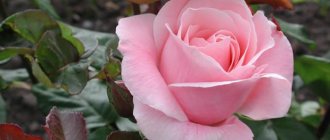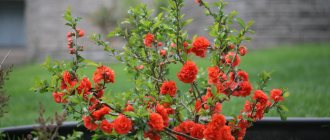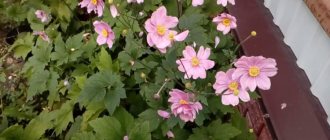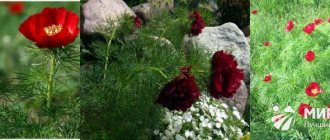What is a park rose
When growing park roses, you need to have an idea about the plant and know all the strengths and weaknesses.
The plant is divided into 3 types:
- cultivated rose hips;
- antique rose;
- modern hybrids.
In appearance, the park rose resembles a rose hip
Park rose blooms in early summer. The color of the flower is multifaceted: snow-white, cream, peach, red and even lilac. The buds are rough and terry to the touch; the number of petals exceeds 100 pieces. Not one varietal plant can boast of these qualities.
Important! Before purchasing a seedling, it is important to understand what a park rose is and how to care for it.
Description and characteristics of the plant
Park rose is a tall, unpretentious shrub with a height of 1.5 to 3 meters. The spreading plant tolerates extreme cold well and blooms profusely and for a long time. The color and structure of the flower depend on the variety. Park rose, like any plant, has pros and cons.
The advantages include:
- long flowering;
- cold resistance;
- large assortment of varieties;
- resistance to diseases.
Disadvantages of the type:
- some varieties need shelter for the winter;
- the plant requires watering;
- Every 4-5 years, it is necessary to divide the bush.
Important! When choosing a variety, it is important to know its frost resistance.
The plant is unpretentious and frost-resistant
Landing
Let's consider the main nuances of preparing for rooting and planting a park rose in the ground.
Preparation
Before planting park roses, it is necessary to properly prepare the soil. The soil in the garden bed needs to be dug up and fertilizers added to it: humus, wood ash and superphosphate. These nutrients will be enough for the plant to last for a whole year.
As for the timing, it is better to plant roses in open ground in the fall. The suitable period is from mid-September until the first frost: the choice of this period is justified by the need for rooting of the seedling. You can plant plants in May - this option is more suitable for cold climates.
How to prepare seedlings
Two-year-old seedlings with a closed root system are best suited for planting.
Preparation:
- the roots must be cut to 1 cm, after removing rotten and darkened rhizomes;
- weak and damaged branches also need to be pruned;
- the remaining shoots are shortened until there are 4 buds left on each shoot;
- before planting, place the roots of the seedlings in a bucket of water 12 hours before planting;
- Immediately before placing in the ground, the roots are dipped in a clay mash.
Planting process
It is necessary to plant plants at a decent distance from each other: roses grow greatly in width. Leave a distance of one and a half to two meters between seedlings. Process:
- A hole is dug and compost, soil and bone meal are added as fertilizer.
- A mound is formed at the bottom of the depression, on which the seedling is placed. The roots of the plant should freely descend along the “slopes” from the formed mound.
- The seedling is sprinkled with soil so that its root collar is covered with two to three centimeters of soil, no more.
- The soil is compacted, watered and mulched.
- Since planting is most often carried out in the fall, the bush must be earthed up and properly prepared for wintering.
Characteristics of crop species and varieties, what they look like
Currently, there are a large number of varieties. They differ from each other in size, flower color, and flowering duration.
Floribunda
Park rose: planting and care in open ground
Today, floribunda rose is one of the popular varieties. The plants are frost-resistant, unpretentious, resistant to diseases and pests, bloom from the beginning of summer until the first cold weather.
Remy Martin
The park rose Remy Martin was bred in France in 1995. The perennial plant is a tall bush with branched, thornless shoots and dense, dark green foliage.
At the beginning of summer, the bush is covered with pointed buds with tightly fitting petals. As they bloom, they transform into double flowers with a diameter of 6-8 cm. The color of the inflorescences is copper-golden with an apricot tint. During the wilting period, the outermost flower petals turn pink.
Inflorescences can be single or collected in brushes of 3-5 pieces. Flowering is long and lasting. As the buds open, a soft, pleasant, unobtrusive aroma appears in the air.
For reference! The variety is immune to fungal diseases; the petals do not fade in the open sun. The plant can withstand frosts down to -25 °C without shelter.
Double flowers up to 8 cm in size
Fluorescent
The variety has a powerful, spreading bush of regular shape. The plant blooms 2 times a season.
The first wave occurs in June, the plant blooms again in mid-July. During flowering, cup-shaped buds appear among the dark green, glossy foliage, which bloom to form double flowers of bright red color.
The inflorescences are collected in a brush of 3-5 pieces, thanks to this the flowering bush looks chic and festive.
Important! Fluorescent is a rose that does not need to be covered for the winter
Repeat-blooming variety
Rose hips
Rosehip or dog rose is a common plant that can be found within the city and in garden plots.
Thanks to the wide variety of varieties, you can create a beautiful flowering combination. Caring for rose hips is not difficult, so it is suitable even for an inexperienced gardener.
Louise Bugnet
Canadian species of park rose. The plant forms a compact bush one meter high. Flowering occurs in 2 stages: the first wave begins in June, the second at the end of July. The variety has a peculiarity - bright cherry buds appear at the beginning, and when they bloom, snow-white petals with a slight pistachio or purple tint appear.
Like all hybrids, the plant does not hold open flowers for a long time. After blooming, the flower lives for 2 days, then the petals fly off. It is replaced by new inflorescences, so the bush looks luxurious throughout the warm period. The aroma of the flower is not strong, but persistent.
The plant is compact, 1 meter high
Marchenland
The 1.5 meter high bush has straight shoots with large, frequently spaced thorns.
Among the large dark green foliage with a glossy surface, large semi-double flowers of a light pink hue with a delicate orange tint appear in early summer. Flowering is long and abundant.
Attention! The garden variety is resistant to diseases, covering is not required. For abundant flowering, the plant is planted in an open sunny place.
The plant is widely used to decorate the garden.
Musk hybrids
This species forms a powerful bush up to 4 meters high. At the beginning of summer, the plant is covered with large double flowers, 8 cm in diameter. The color of the inflorescences depends on the variety. For abundant flowering, it is important to plant the rose in an open, sunny place.
Elmshorn
The variety was bred in Germany in 1951. A tall, vigorous bush reaches 2 meters in height.
At the beginning of flowering, the inflorescences are painted a soft crimson color; as the petals bloom, they become dark pink. In hot weather, double flowers may fade.
Inflorescences are collected in a brush of 10-20 pieces. During flowering, the air is filled with a light nutmeg aroma with apple notes.
Important! The variety is resistant to diseases and, with proper care, can bloom again at the end of summer.
Flowers are collected in brushes of 10 pieces
Lichterlo
An erect bush, up to 80 cm high, densely covered with dark green leathery leaves. Flowering is abundant and long lasting. At the beginning of summer, the plant is covered with blood-red double flowers, 8 cm in size.
The variety is winter-hardy and unpretentious. For abundant flowering, the seedling is planted in an open sunny place, protected from northern winds. The rose is planted singly, in rose gardens and composition plantings. Cut flowers last a long time.
Flowers exude a delicate aroma
Shrubs
This shrub group appeared 50 years ago. There are tall, low and climbing varieties. Branched varieties require support. They are frost-resistant and rarely suffer from diseases. Flowering is lush and abundant, long lasting or repeated. Flowers exude a pleasant aroma.
Moden Fireglow
The Canadian rose forms a dense, erect bush 100 cm high. The variety has high winter hardiness and beautiful flower color. Rich orange-red semi-double flowers are collected in brushes of 3-5 pieces.
The first flowering is abundant; at the end of summer, single specimens appear on the bush. In autumn, after flowering, round, multi-seeded fruits are formed.
Important! The variety is highly resistant to powdery mildew and moderately resistant to black spot.
Salmon-red flowers exude a delicate aroma
Ghislaine de Feligonde
This variety is often used to create hedges and vertical gardening. The re-blooming shrub reaches up to 2 meters in height.
At the beginning of summer, the plant is covered with small peach-pink flowers, which change color to a lighter color as they bloom. In sunny weather, the petals fade and become white; in cold weather, the flower has a pale pink color.
All flowers change color unevenly, which makes the plant multi-colored.
The plant is disease resistant
Explorer Series
This group belongs to high quality Canadian rose. The varieties are resistant to low temperatures, bloom for a long time and profusely. The flower color ranges from light pink to dark red. The disadvantage of the group is its poor resistance to prolonged rains.
Cuthbert Grant
An outstanding variety with cupped, semi-double flowers of deep purple. When fully opened, bright yellow stamens can be seen in the center. 3-9 flowers are collected in brushes and located on strong, elastic shoots. The bushes are erect, reaching a height of up to 120 cm. Large ash-green foliage harmonizes perfectly with bright flowers with a persistent strong aroma.
The variety is frost-resistant, hardy and unpretentious. Not afraid of temperature changes, blooms throughout the warm season. It takes good cuttings; the bush is not covered for the winter.
Semi-double dark purple flowers
Shrub roses
The bush group reaches a height of up to 3 meters and produces large flowers of various colors. The varieties included in the group are not whimsical and belong to non-covering roses.
Eifelsauber
A young variety bred in Germany in 2008. The durable shrub grows 70 cm in width and 120 cm in height.
In early summer, pointed orange-red buds emerge from the dark green foliage. As the petals bloom, they acquire a light pink color with a delicate aroma.
Flowering is long and repeated. The first wave occurs in June, the second time the bush blooms in mid-July. The densely double flowers are large and have a strong aroma. This winter-hardy rose variety is unpretentious, making it suitable for beginner gardeners.
Flowers are collected in a brush of 3-5 pieces
Also, experienced gardeners recommend other unpretentious varieties. Name of popular park roses:
- Westerland - suitable for landscaping vertical buildings;
- John Davis is a refined aristocratic variety;
- Lady of Shallot is one of the most frost-resistant and unpretentious varieties;
- Abraham Derby - the variety was bred by the famous breeder David Austin;
- Agrant is a re-blooming variety with a strong aroma.
Important! All varieties of park roses can be purchased at an affordable price. The average cost of a seedling in April 2021 is 300 rubles.
Reviews from gardeners
Lyubov, 59 years old, Chelyabinsk
Königen von Denemark has been growing in my dacha for many years. I can say that this is a very hardy rose, it overwinters without shelter, and has never suffered from black spot. The flowering is very lush, the bush is simply strewn with roses. The flowers have a stunning scent of rose oil. I collect the petals and just dry them. I use it in tea and baked goods as a flavoring in winter. But, apparently, not only I like this rose; various pests often settle on it, and I have to fight them.
Alexandra, 57 years old, Rostov region
Of the tried and true vintage roses, my favorite is Maiden Blanche. Absolutely problem-free, grows in partial shade, is not afraid of frost, I don’t cover it for the winter. The flowers are large and very fragrant. The leaves are also beautiful, with a bluish tint. It's a pity that it only blooms once.
Alla, 62 years old, Moscow region
Rose Louise Odier planted it in her dacha 6 years ago. During this time, it grew from a small seedling into a huge bush. It blooms very luxuriantly and for a long time, all the branches are strewn with pink, very fragrant flowers that scent the entire garden. I make wonderful aromatic jam from the petals. In the winter I bend the branches to the ground and cover them, it overwinters normally.
Classification of park roses
Indian onion - what it is, what it looks like
Park roses are divided into single-blooming and repeat-blooming roses. These species differ in care rules, flower color and winter shelter.
Single flowering
Once-blooming varieties are not recommended to be pruned, as the flowers appear on last year's shoots. The rose does not require bending down shoots and shelter for the winter. This group is called cultivated rosehip. Due to their unpretentiousness, such roses are often grown in garden plots in regions with harsh climates.
The most popular varieties:
- Wasagaming;
- MinnEt;
- Poppius the scrub.
With repeated
Repeat blooming roses are divided into 3 subgroups;
- frost-resistant varieties of roses;
- Canadian park roses;
- a group that does not overwinter without shelter.
Hybrids are frost-resistant, but the species cannot boast of a variety of flower shapes and colors. Some rugosas need shelter from the cold.
Canadian roses are very popular. Flower growers distinguish the following varieties: Morden Centenial and Prairie Joy.
Among the covering varieties there is a wide variety of shapes and colors. This group includes ancient re-blooming and Burgonian varieties, as well as Fisherman Friend, Meyana, Cordessa, Tantus.
Care
Let's look at the main points for caring for a park rose.
Watering
Immediately after planting, roses need plenty of moisture. Young seedlings are watered every day, avoiding, however, waterlogging and the formation of a swamp. The above-ground part of the plant cannot be moistened or sprayed - this can lead to the development of powdery mildew.
If the climate is arid, when planting in a hole, it is recommended to add hydrogel, which promotes better and longer-lasting hydration of the roots.
Rooted roses need fairly abundant but infrequent watering. It is important that the water reaches the roots and moisturizes them well. If you moisten in small portions, this will lead to superficial and chaotic growth of the root system. And the shallow location of the roots leads to their freezing in winter. For a variety like the famous Consuelo, freezing is critical.
By the end of summer, gradually reduce the amount of watering. In the fall, you don’t have to water it at all to avoid the appearance of vigorous young growth.
Top dressing
Fertilizers begin to be applied from the second year, since when planting a sufficient amount of organic matter and minerals are already introduced into the hole. It is recommended to use complex mineral fertilizers rich in microelements. The following compositions are suitable:
- "Clean slate" for roses;
- Biocomposition "Buy fertilizers";
- Biocomposition "Hera" and some others.
During the growing season, roses need to be fed 2-3 times. In the fall, manure is added to help the plant form a strong skeleton, roots and branches. In spring, the plant should be fed with magnesium, boron, iron and nitrogen. Organic manure feeding will also not hurt in the spring.
Fertilizers are applied for the second time in August, using phosphorus, calcium and potassium compounds. You can fertilize again before wintering: only with organic fertilizers (compost is ideal).
From time to time, water your roses with an infusion of wood ash, which contains many beneficial microelements.
Loosening, mulching
These procedures are also useful and are best carried out after watering. Roses need loose soil, and mulching will help retain moisture at the roots longer.
Trimming
Growing should also include the formation of a bush: this procedure helps to make the plant compact and blooming luxuriantly. In the first two to three years of life, roses are not pruned; however, young shoots are removed at the end of each summer.
Attention: when performing pruning work, be sure to wear a tarpaulin apron and mittens: rose thorns can scratch quite severely.
Wintering
Before the onset of cold weather, the plant must be hilled up: the mound of earth around the bush should rise to a height of 20 cm. In a warm climate, a rose can overwinter without shelter, but in a cold climate and if the plant is still young, it is necessary to cover it.
It is necessary to cover the rose when the temperature drops to +5 degrees. The material used is agrofibre, lutrasil, and the top is covered with spruce branches. If there are thaws in winter, raise the shelter so that the rose does not overheat.
Uncovered park roses
Evergreen cypress - what it is and what it looks like
Many beautiful varieties are frost-resistant and do not require shelter for the winter. There are 3 types of roses that can withstand winter cold:
- Moderately winter-hardy - can freeze in places where there is no snow cover.
- Winter-hardy - tolerate frost well in an upright position, but in severe frosts they can freeze.
- Absolutely cold-resistant - this means that the varieties are not afraid of the most severe frosts.
In order not to lose the plant, it is better to cover the young seedling for the winter.
For wintering without shelter, it is important to follow simple rules:
- landing is done in a place protected from the winds;
- the soil must be well drained;
- groundwater should not be located superficially;
- for successful wintering, the bush requires careful care;
- Roses are best grown in a well-lit area.
Main diseases and pests of crops
Most varieties of park roses are immune to diseases and pests. But if agricultural practices are not followed, the following can settle on the bushes:
- Powdery mildew - a white coating appears on the foliage, which can be easily removed with a finger. Without treatment, the plant dies. You can help the plant by spraying it with copper-containing preparations.
- Rust - in the spring, small tubercles with fungal spores appear on shoots and foliage. To stop the development of the disease, the bush is treated with Bordeaux mixture, nettle or wormwood decoction.
- Black spot - the leaf blade is covered with dark brown spots with a yellow border. If a disease is detected, the affected areas are removed and the bush is sprayed with foundationazole or pine decoction.
Among the insect pests on the park rose, aphids often appear, which, by sucking the juice, significantly weaken the plant. You can get rid of it with insecticides or folk remedies.
Prevention from diseases will allow the park rose to become the pride of the gardener
The park bush rose is a beautiful, unpretentious plant. By choosing the variety you like best and following the rules of care, you can grow a gorgeous bush that will bloom profusely and for a long time, emitting a pleasant aroma. Thanks to luxurious, spreading bushes, you can not only transform your garden plot, but also mark its boundaries.











